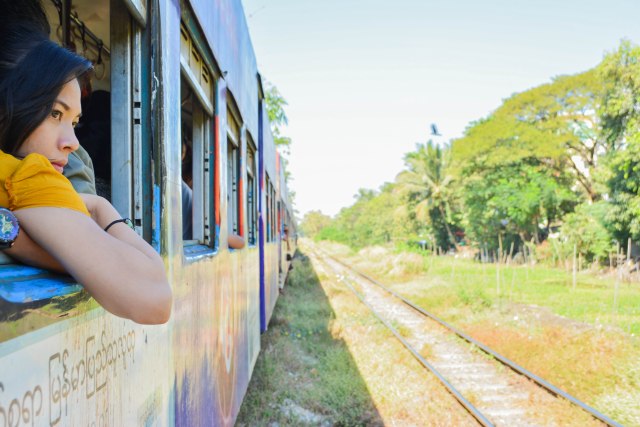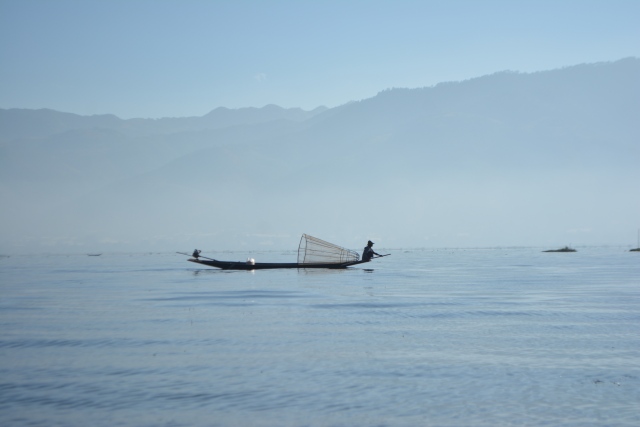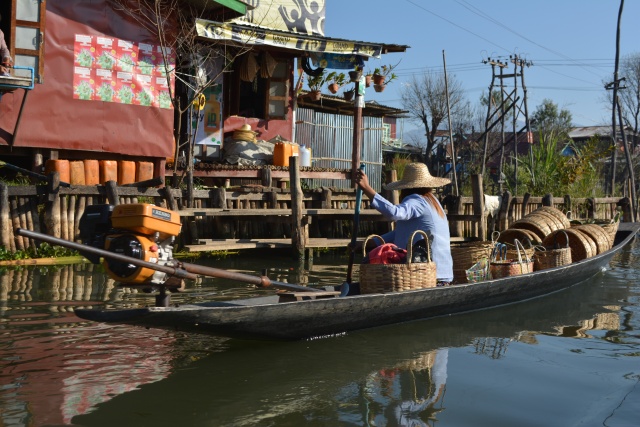No south east Asian itinerary is complete without a visit to magical Myanmar. You’ll sail on smooth lakes in the shadow of mountains, cycle past ancient temples, roam golden pagodas and meet dozens of friendly smiling locals.
If you’ve got this beguiling country on your bucket list, check out the must see destinations in Myanmar.

1. Explore the Schwedagon Pagoda
The top spot in Yangon is the dazzling Schwedagon Pagoda – one of the world’s largest Buddhist temples.
The pagoda shimmers in the sunlight with its captivating golden hues, and it’s worth a visit during both the day and night.
The 100-metre gold plated and diamond topped main stupa sits high on Singuttara Hill in the Schwedagon Pagoda complex and is visible from many areas of Yangon city. The complex has been expanded over the years, but a religious site has existed on this hill for more than 2,500 years.
The story goes that two brothers who lived in Yangon met the Buddha in India. The Buddha gave them eight of his hairs and told the brothers to enshrine them in Yangon in the spot where three previous reincarnations of the Buddha were buried. This spot was Singuttara Hill and the Schwedagon Pagoda was born.
There’s four entrances into the pagoda complex guarded by huge mythological lions called Chinthes. It doesn’t matter which entrance you take so just pick one, take off your shoes, and head into the golden complex and explore the many stupas and statues.
Prepare to spend a couple of hours here exploring, watching local people deep in prayer, and witnessing burgundy robed monks sedately wandering the grounds or praying.
At each corner of the pagoda is a shrine with a Buddha image. There’s one for each day of the week. Devotees pray to the shrine belonging to their day of birth – burning candles or incense, offering flowers and pouring water over the Buddha’s head.
To enter the pagoda, you’ll need to cover your knees and shoulders (no shorts or singlets) and take off your shoes. You can take your shoes with you or leave them at a shoe storage counter.

2. Roam Yangon’s colonial centre
After you’ve had your pagoda fix, head into Yangon’s centre and check out the colonial architecture of the downtown area. The streets around the relaxing Mahabandoola Park are lined with colonial era buildings dating back to the late 19th century.
The British occupied much of what was then known as Burma in the late 1800s. Yangon became the capital and a number of buildings were built during this period in colonial style. After the capital was moved to Naypyidaw, most of the buildings were abandoned and sadly left to decay – but the buildings offer an interesting look at Myanmar’s past.

3. See how the locals live with a train ride
If you want to get a sample of local life, hop on Yangon’s Circle Line commuter train – a three- hour, 49-kilometre journey that loops around Yangon city. Here you’ll see local people commuting through Yangon, market vendors, and locals with their fruit and vegetable haul.
Taste local food from the hawkers who board the train at every stop. Apples and corn are popular, or you can get a doughnut like treat covered in a sweet syrup.
This is the place to people watch and see Myanmar life, hang out the door to catch a breeze and take in the surrounding fields and villages.
The best station to get on the train is at the Yangon Central train station off Pansodan Street. The train departs from Platform 6 or 7. You pay for the ticket at a counter on the platform.
The train does a loop so you can get off at any station and usually there’s a taxi or two at most stations so you can get back to Yangon, or you can simply choose to do the full circuit.


4. Sail away on Inle Lake
Myanmar’s Inle Lake is one of Myanmar’s major drawcards. The vast, calm lake is 11 kilometres wide and 21 kilometres long.
Prices start from $25 USD to hire a long boat with a driver for a day of explorations across Inle Lake and through the surrounding canals. The long boats fit five people.
You’ll get your own boat driver who escorts you to the dock, guides you to sit down on a wide wooden chair on the deck of the open boats, and then you set sail on the smooth blue waters of Inle Lake.
Once out of the canals of Inle Lake’s gateway town, Nyaungshwe, you’ll be greeted by Intha fishermen on traditional boats, using one leg to stand on and the other leg to power the paddle rather than their hands and arms. They use this technique to guide the boat as the waters are so clear and calm, they can often see down into the water to steer clear of weeds and then spot the distinctive bubbles of fish below. By propelling the boat forward with their legs, it leaves their hands free to guide their unique conical net into the water and catch the fish.
Sit back, relax and see local life going on around you in the floating villages.

5. Visit ancient ruins
During your Inle Lake excursion, make sure you take the side trip to the Indein ruins.
On your way to Indein, you’ll likely traverse the beautiful canals of the Ywama Village, distinctive with its stilted houses and quaint arched bridges.
Indein is a smaller version of Myanmar’s better known ancient city of Bagan, but is also filled with sandstone pagodas, many of them populated with Buddha statues. The ruins date back to the 16th century, and about 1000 pagodas and stupas remain from more than 2,000.

6. Wander through an ancient city
One of the best places to experience this captivating country is the ancient city of Bagan.
Bagan was built between the 9th and 13th centuries but was abandoned in the 13th century due to invasion, and the many thousands of religious monuments were left to decay. But fortunately, more than 2,000 monuments still remain, scattered across a massive 40 square kilometres.
Your journey through the expansive ancient city starts only a few kilometres from the airport. As you wind your way to Old or New Bagan, you’ll soon spot the brown stone temples of Bagan peppering the roadside.
The best way to explore Bagan is on a bicycle or electric scooters called e-bikes. These can be hired from your accommodation or across Bagan for AUD$8 for the day.
Bagan still retains a very authentic feel with dirt paths leading around the site. Due to the expansiveness of the site, you will often get temples all to yourself.
There’s more than 2200 religious monuments across Bagan’s fields so there’s plenty to explore. The temples come in all different shapes, colours, and sizes and many contain frescoes and Buddha statues. You can climb up onto the terraces of many temples and get a great view.

7. See sunrise from a pagoda
When in Bagan, you have to go see a sunrise. Sunrise is a magical time with the many temples gradually being lit up across mist scattered plains; streaks of orange and pink painting the sky; and hot air balloons slowing rising above the ground.
The pyramid style Shwesandaw Pagoda is the most popular temple to see sunrise from as it’s the highest in the area. If you’re planning on heading up to this pagoda, organise to get there early to secure a good vantage point as the tour buses also stop here.
Steep stairs lead up to each of the pagoda’s five terraces. The terraces offer 360-degree views and provide a great view of the hot air balloons as they take off so it’s no surprise this is a popular sunrise spot.
The Low Ka Oushang Pagoda is only a 5-10 minute walk from Shwesandaw and is a lot smaller. The pagoda offers one terrace area with a few higher vantage points.
A small fee applies to enter the pagadas for sunrise.
The Shwesandaw Pagoda is also a popular spot for sunset, but you can also get off the beaten path and head to the Pya Tha Da Pagoda.

Getting Around Myanmar
Myanmar is serviced by small airports in Yangon, Mandaloy, Bagan and near Inle Lake (Heho), or you can also get around by bus, mini van or hire a driver.
It’s easy to arrange your mode of transport when you arrive in Myanmar. Most hotels and guesthouses will be able to arrange it for you or there are tour agencies represented in tourist areas.
It’s also possible to take a cruise from Bagan to Mandalay down the Ayeyarwaddy River when river conditions allow.
If you like to hike, there’s also the option to hike from Kalaw to Inle Lake.

Find out how much it costs to backpack in Myanmar for 24 days in this blog from The Wandering Westerner.
Entrance Fees
Entrance fees apply to enter tourist areas in Myanmar. Prices are subject to change.
At the time of writing, the archaeological fee to enter Bagan was $15 USD per person.
Entry into the Inle Lake area is $10 USD per person.
It costs $6 USD per person to enter the Schwedagon Pagoda in Yangon.

Things You Should Know
• Many nationalities can apply for an e-visa to enter Myanmar. You can apply online to enter Myanmar at www. https://evisa.moip.gov.mm Visas are valid for 90 days to enter Myanmar from the date you receive your approval notification. You may receive this within 1-3 days of your application. You simply have to print out this approval confirmation and present it to the Immigration Officer on arrival along with your passport. Check the e-visa website for details on approved entry points. You can stay in Myanmar for 28 days from the date of entry. The visa costs $50 USD.
• ATMs accept foreign cards.
• US Dollars will be accepted in many places across Myanmar and many prices will be quoted in US Dollars. US Dollars will be accepted by taxi drivers. It’s best to bring bills without marks or tears.
• Cash is best in Myanmar. While some hotels will accept credit card, cash is preferred. A fee of 3% of the amount charged will be added if you use your credit card.
• E-bikes are a great way to get around Bagan. Expect to pay about $5 USD for 8 hours. The e-bikes are electric, and their charge lasts about 8 hours.
• You’ll need to cover your knees and shoulders and remove your shoes to enter religious sites.
